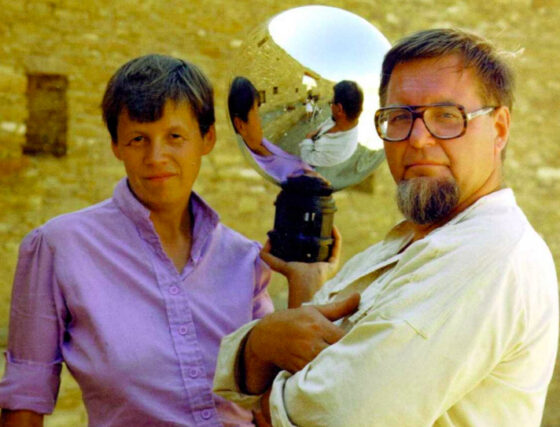Exploded View: Steina & Woody Vasulka

By Chuck Stephens.
Icelandic filmmaker Hrafnhildur Gunnarsdóttir’s extraordinarily warming 2019 documentary The Vasulka Effect, about the protean Euro-hippies and rightfully dubbed “grandparents of video art,” Steina and Woody Vasulka, was exactly the movie I needed to see this winter. Awash in Nordic echoes even as it confronts the modern realities of art-gallery politics and the history of America’s visual-arts fringes, it’s a mythical origin story that’s actually true, all about ancient heroes and ravaging time. In it, the hot gusts of youth and fertility and cheap loft spaces filled with cheap weed fumes (in the Manhattan of the ’60s) are eventually, in a rhythm any of us codgers can instantly recognize, confronted with the cold winds of accelerating decrepitude. Our heroes appear virtually vanquished, not by enemy blows but by the retreat of culture’s restless spotlight. Poverty, indifference, disintegration, and oblivion all wait by the door. But rather than charting a downward spiral, Gunnarsdóttir’s generous, delightfully physical, and ultimately very winning film is, to everyone’s delight, instead able to chronicle an altogether buoyant journey in which our heroes retain their rightful glory, and the world seems a richer place for it. This time, the hippies win.
The Vasulkas invented video art, often literally so. Woody (1937-2019), a would-be filmmaker and natural tinkerer, was Czech; Steina (born 1940), a violinist and intuitive video-performance artist, long before anyone knew there was such a thing, was from Iceland. They met in the politically oppressive Art School atmosphere of early-’60s Prague, fell in love—or simply “fell in” with one another as life partners, a distinction made somehow marvellously irrelevant here—and eventually got to Manhattan. Parties were held, connections were forged, history was made. The couple spent the ’60s mastering the art of video reportage while taping porn-theatre troupes and concert headliners like Jimi Hendrix and Jethro Tull, and staging live video-processing art events which considered both the possibilities inherent in, and expandable from, the primitive tools first available to them, and the potentials in the interface between video performance and its growing (if still tiny) audience. Woody hand-wired circuit boards for early video synthesizers and scavenged junkyards for parts to build gyroscopic camera mounts; Steina found ways to marry the violin with video signal processing (paving the way for Laurie Anderson) and envisioned foundational video-gallery installations and environments. By 1971, the Vasulkas had opened the legendary artspace The Kitchen, and New York’s “downtown scene” was transformed forever. (Cue everyone: gender-blur genius Jackie Curtis, Robert Mapplethorpe, Cindy Sherman, then-neophyte modern video-art giant Bill Viola…)
Importantly, the Vasulkas were always explaining how they were using the technology as they went along: this is the gear, this is the setup, this is the “art”—those raster-squiggles and strangely three-dimensional video-transformations of the everyday (Steina’s grin, for example, or traffic in the street below.) Art, education, and “having fun with it” seemed the couple’s only goals…along with, very presciently, maintaining their own meticulous archive of their accomplishments, and the gizmos that helped accomplish them, which they continued even as they slipped into obscurity and destitution in the years following their departure from the faculty at SUNY Buffalo for a dusty roadside retreat in New Mexico. It would be their salvation, once a new generation of motion-arts enthusiasts and moneyed curators came of age and rediscovered the manifold pleasures of their space-age, first-generation creations.
Today, there are myriad Vasulka resources online, beginning with the oddly antiquated and labyrinthine vasulka.org, a site filled with ample riches beneath mysterious menu-hierarchies, and examples of their work are available everywhere from YouTube and Vimeo to all the usual bootleg repositories. Our most intrepid enthusiasts are directed to the Vasulka Kitchen in Brno and Vasulka Chamber in Reykjavik, two splendid foundations dedicated to the artists’ legacies. Context is everything though, and if you’re just beginning, Gunnarsdóttir’s film is a most excellent way in. Amidst The Vasulka Effect’s ample history, she simply lets the Vasulkas stand for themselves, naked, grinning, and unafraid of time.
Chuck Stephens- « Previous
- 1
- 2


